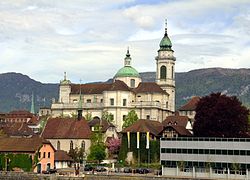Solothurn Cathedral
| Cathedral of St. Ursus | |
|---|---|
| Cathedral of St. Urs and Viktor | |
| German: Kathedrale St. Urs und Viktor | |
 |
|
| 47°12′30″N 7°32′22″E / 47.208311°N 7.539466°ECoordinates: 47°12′30″N 7°32′22″E / 47.208311°N 7.539466°E | |
| Country | Switzerland |
| Denomination | Roman Catholic |
| Website | Diocese of Basel |
| History | |
| Consecrated | 26 September 1773 |
| Architecture | |
| Status | Cathedral |
| Functional status | Active |
| Heritage designation | Heritage site of national significance |
| Architect(s) | Gaetano Matteo Pisoni, Paolo Antonio Pisoni |
| Architectural type | Cathedral |
| Style | Neoclassical |
| Groundbreaking | 1763 |
| Completed | 26 September 1773 |
| Specifications | |
| Number of spires | 1 |
| Spire height | 66 m (217 ft) |
| Materials | Solothurn Limestone |
| Bells | 11 |
| Administration | |
| Parish | St. Ursen, Solothurn |
| Diocese | Basel |
| Clergy | |
| Bishop(s) | Felix Gmür |
The St. Ursus Cathedral (Cathedral of St. Ursus) or Solothurn Cathedral is the cathedral of the Roman Catholic Diocese of Basel in the city of Solothurn, Switzerland. It is a Swiss heritage site of national significance.
Ursus and Victor were 3rd-century Roman martyrs and saints. They were associated very early with the Theban Legion, who were, according to the hagiography of the legion, martyred for refusing to worship the Emperor. The Life of Ursus was written by Saint Eucherius of Lyon in the 5th century; it recounts that Ursus was tortured and beheaded under Emperor Maximian and the governor Hyrtacus for refusing to worship idols around 286.
The first church on the site was built in the Early Middle Ages. St. Ursus of Solothurn was venerated in the city by the 5th century. By 870 there was a college of canons and presumably a collegiate church in Solothurn. A Romanesque church might have existed, but there is no written or archeological evidence to support or refute it. The first documented record of the Gothic church comes from 1294, while the altars were ordained in 1293 and 1298. J.R. Rahn wrote in 1893 that 1294 was the completion date of this church. Hans Rudolf Sennhauser wrote in 1990 that the shape of the crypt was inconsistent with a 1294 construction date. He felt that the two-piece crypt with a double row of pillars was replaced with a single part crypt around 1100. Since the pre-1762 church had a two-piece crypt, he believed it dated from before 1100.
...
Wikipedia

